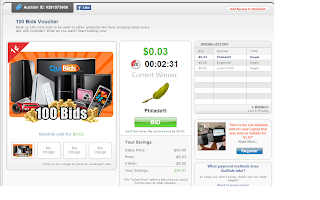This is Part 3 of the series on Quibids strategies that I want to publish. These strategies are not conjured up from thin air. They are written from personal experience, but more importantly, personal research. Most penny auction strategies, like Quibids strategies, are to do with Game theory and probability.
You can also find
Part - 1 and
Part - 2, which deal with different strategies.
Theoretical Efficiency Vs. Practical efficiency:To understand Quibids and indeed any other Penny Auctions, you should first understand that the theoretical best Quibids strategy need not be the best practical strategy.
To illustrate, consider a typical Quibids macbook auction, as shown below:

The cost of the Macbook, finally, was
$426.65. This was a 1 cent Quibids auction (see the top left hand side of the image). This means each bid incremented the cost of the macbook by 1 cent. Thus, in all, there were
42,665 bids placed. That's quite a lot of bids!
Now, consider the time it takes for placing these many bids. This is a really hard question to answer, as anyone who has followed the Quibids auctions knows. There could be 2 people bidding in tandem, in which case things can move quickly but usually people only place their bids when there are less than 5 seconds left.
As an average case, I am assuming it takes 2.5 seconds between bids (I think it is a good number for an average in this case. Other smaller auctions usually have larger average time between bids).
So the time required to complete the auction is 42,665 * 2.5 seconds = 106,662.5 seconds. This comes out to
29.6 hours. That is a huge time interval of over 1 day!
Now, let me ask you - how many people can sit non-stop in front of their computer looking at the auction process for nearly 30 hours to choose their best strategy? Not many.
This is why the
theoretical best Quibids strategies will differ so much from the practical best Quibids strategies. Best Theoretical Quibids Strategy: Here is the best theoretical Quibids strategy:
Wait for the last moment to place your bid. This means, bid on the Quibids auction when the timer is 1 second.
This seems simple enough and most people intuitively do use this for their bidding - let the people fight it out and I'll come in when the time is right.
This is a simple strategy and people are easily deceived by its applications. Let me expose the myth that this is THE strategy to apply to penny auctions. In fact, all the videos on Youtube that claim to show 100% Quibids strategy wins simply use this basic technique, which turns out, isn't the best practical strategy after all for all Quibids auctions.
The problem is, this
isn't always the best practical strategy. For example, in the above Macbook auction, can you sit for 30 hours non-stop in front of your computer to see when the timer reaches 1 second? Well, I don't think so.
When to use this Quibids Strategy: The waiting game strategy should ONLY be used for
small Quibids auctions. By small, I mean auctions that usually have less than 200 bids placed on them. In such cases, you can win Quibids auctions by using this Quibids strategy of waiting till the timer goes to 1 second and bidding.
Word of Caution: When you are using this waiting game Quibids strategy, it is very important that you
never quit! This holds even if there is an aggressive bidder, using a strategy I described
here (who uses the volunteer's dilemma problem).
The reason for this is simple: If you quit, you will be left with nothing at all. This doesn't hold for all strategies, but in this instance, you must not quit.
Why People Fail? This particular Quibids strategy seems intuitive - you wait till the last moment to bid, thus saving your bids and ensuring they are not wasted when someone else is placing his bid before yours.
So why do people fail? Simple - they quit!
When someone is bidding aggressively, they will quit. The problem with this strategy is that it appears to reduce risk, while the truth is it can practically be a very high risk Quibids strategy. The reason for this is what people practically do - they get intimidated by aggressive bidders and never win. They lose a few bids in hundreds of auctions and thus they end up with nothing to show for their efforts and bids.
Therefore, this seemingly simple Quibids strategy can backfire and you need to ensure you know exactly why, when and how to use it. Do not try this on big auctions like Holiday trips, cars and macbooks.
What Auctions Can I win this way? Try out the smaller bids: 15,25 bid auctions are ideal for this. Also, anything with a price of less than $30 can be a good start. Once you know how never to quit and understand how Quibids auctions work, you can proceed to slightly bigger auctions (but never on the heavyweights!)
Good luck Quibids bidding!

























